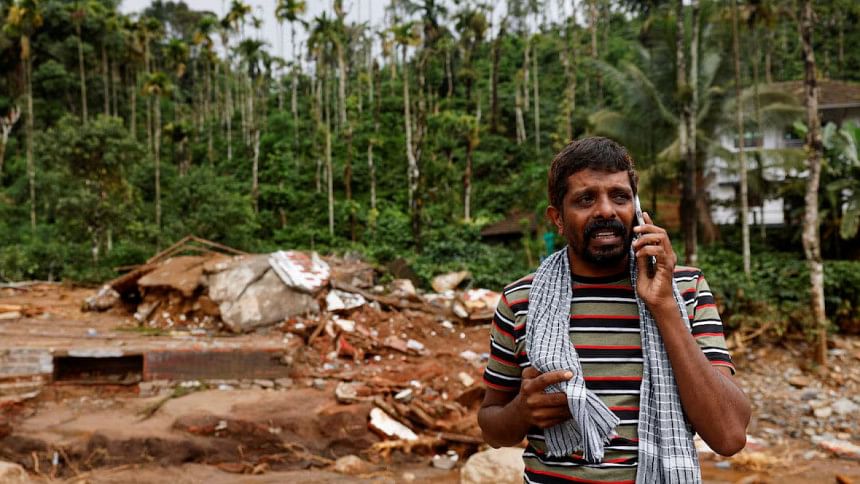Will India learn anything from the Wayanad Tragedy?

The deadly waves of landslides, triggered by incessant heavy rains in the hills of southern Indian state of Kerala's Wayanad district, has once again brought to sharp focus the debate over development and ecology.
Following the first day of the landslides on July 23, the Indian Environment Ministry issued a fresh draft notification declaring over 56,800 square km of the Western Ghats as an Ecologically Sensitive Area (ESA) spanning six states, including the devastated Wayanad villages. This was the sixth such notification by the Environment Ministry in a decade since 2014, but the final notification has never seen the light of the day after running into objections from political parties and governments.
The Western Ghats, among the world's eight most important biodiversity hot spots, runs between India's south to west through Kerala, Tamil Nadu, Karnataka, Goa, Gujarat, and Maharashtra. What is at stake is the life of more than 50 million people living in the region, most of them dependent on agriculture and plantations.
According to official documents, the significance of the Western Ghats as a global biodiversity area and a treasure trove of biological diversity has been repeatedly emphasised. It is also the origin of Godavari, Krishna, Cauvery, and a number of other rivers of peninsular India, on which depends much of the economy of the region.
Environmental scientists have attributed the landslides to a combination of loss of forest cover due to unregulated infrastructure development, quarrying, mining in the fragile terrain, and climate change. The increase in the rainfall on Kerala in recent years is seen by environmentalists as the result of warming of the south eastern part of the Arabian Sea, causing heightened precipitation.
In 2011 , an expert panel set up by the Indian government, led by ecologist-academic Madhav Gadgil, had submitted a report, recommending a ban on these activities and designating 75 percent of the entire Western Ghats region as an ecologically sensitive zone (ESZ), a graded zonation approach to regulating industrial and agricultural activities and creation of an overarching ecological authority for the region. The expert report is gathering dust following resistance by political parties, which opposed cutting down the ESZ areas for industries and other development activities. The opposition has largely stemmed from fears that any move to ban certain activities and the demarcation of whole villages as ESAs will deprive the local people of economic growth opportunities.
Another government-appointed committee, headed by leading scientist K Kasturirangan, had suggested in 2013 that the Meppadi Panchayat in Wayanad, one of the most severely affected places by the July 23 landslide, be included in the larger eco-sensitive zone being demarcated in the state. The Kasturirangan panel proposed 37 percent of the Western Ghats be demarcated as ESA because the previously proposed 75 percent figure was considered too high. However, the Kasturirangan committee recommendations also remain unimplemented.
Maharashtra's Congress-NCP coalition government submitted to the federal Environment Ministry in 2012 that the creation of an overarching Western Ghats Ecological Authority would run parallel to existing government agencies and opposed the idea. Kerala, Maharashtra and Tamil Nadu opposed a proposed ban on new hydropower projects in the region.
In 2022, the BJP government had issued a notification of ESAs in the Western Ghats but the party's government in Karnataka opposed the move. The then Karnataka Home Minister, Aranga Jnanendra, had said, if the draft notification was accepted as it was, "it will affect the lives of people in rural areas."
The Indian Express quoted Pandurang Hegde, an environmental activist associated with the Save Western Ghats Movement in Karnataka, as saying that irrespective of which political party is in power, they have always projected protection of Western Ghats as an "anti-people issue."
Hedge added, "Those with vested interests desiring to exploit natural resources do not want the demarcation of ESAs and politicians have used local people as a shield to justify the delays."
In an article in The Indian Express, Amitbah Kant, India's G20 Sherpa, says a 2022 study on depleting forest cover in Wayanad showed 62 percent of the district's green cover disappeared between 1950 and 2018, while rubber plantation cover rose by around 1,800 percent.
The intensity of the landslide increased because rubber trees are less effective in holding soil compared to the dense forest cover of pre-plantation times. Besides, the sharp rise in eco-tourism in Wayanad, one of the most scenic spots in India, has gone on unchecked in the last so many years with the construction of hotels, resorts, and roads through the hills.
The main challenge is aligning the biodiversity of the Western Ghats region with adequate opportunities for the local people in the broad framework of ESA. It is not merely an issue of development regulation, but is intimately linked to positive promotion of environment-friendly and socially inclusive growth.
Pallab Bhattacharya is a special correspondent for The Daily Star. He writes from New Delhi, India.

 For all latest news, follow The Daily Star's Google News channel.
For all latest news, follow The Daily Star's Google News channel. 








Comments